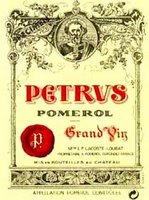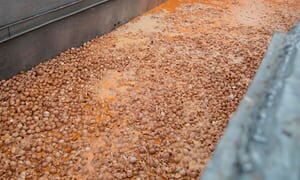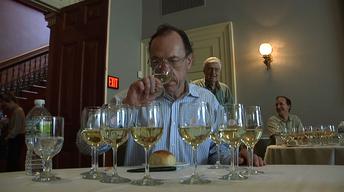We may disagree about our favorite artists and musicians, but it’s relatively easy to agree that a particular color is blue, or that a particular note is C-sharp. They’re described by wavelengths and frequencies along a clearly defined spectrum. That’s why the technologies of visual and auditory reproduction—photo, video, audio—work so well, relatively speaking.

Worth a thousand words?
With taste and smell—the so-called “chemical” senses, which are more complex (humans have about 400 different types of olfactory receptors) and less well understood than the others, we don’t have the luxury of those points of reference. That’s why we so often resort to loose analogies—“tastes like chicken”—and it’s also why reproducing tastes and smells is so difficult (grape soda doesn’t taste much like grapes, and nobody’s yet synthesized a bottle of 1945 Pétrus—an activity that would surely yield tremendous profit).
To challenge this barrier, we resort to analogy. Coffee tastes like nuts and chocolate; Sauvignon Blanc smells like grapefruit and cat pee. In a Sauternes, you might sense the brine of the first green olive you tasted in Italy; in a Pedro Ximénez sherry, the viscous maple syrup that your grandmother once drizzled on your pancakes.
But how carefully are we really choosing these adjectives and analogies? How often do they correspond to real chemical commonalities? Does that matter? Do the analogies more frequently serve a more poetic (or at least suggestive) purpose, forging new neural assemblies that connect relatively arbitrary taste and smell memories with each other—connections that, reinforced over time, turn into sensory reality?
Two papers at last month’s meeting of the American Association of Wine Economists in Reims (this is my second of two articles about the conference) investigated this question with respect to the wine industry, which is, if not a microcosm of all consumer-products industries, at least an increasingly apt caricature of them. While creative adjectivism has long characterized in the wine world, the practice in other taste industries—chocolaty coffee, metallic fish, grassy honey, peaty whiskey—is now ascendant.
The canonical work in the wine-adjective field is Princeton economist Richard Quandt’s “On Wine Bullshit” (a riff on his fellow Princetonian Harry Frankfurt’s “On Bullshit”). Writes Quandt:
Two things have to be true before wine ratings can become useful for the average wine drinker. Since there are many wine writers, and there is a substantial overlap in the wines they write about (particularly Bordeaux wines), it is important that there be substantial agreement among them. And secondly, what they write must actually convey information; that is to say, it must be free of bullshit. Regrettably, wine evaluations fail on both counts.
At the AAWE meeting, Coco Krumme of M.I.T., who is also a Fearless Critic food writer, studied data from critical descriptions of more than 3,500 wines from recent vintage years, ranging from $4.99 to $137.99 in retail price, and employed a Bayesian filter to “find those words that best predict the price category of a bottle” (abstract here). She found that “about 65% of commonly occurring words are non-overlapping.” Words like “old,” “elegant,” “intense,” “supple,” “velvety,” “smoky,” “tobacco,” and “chocolate” predict expensive wines; “pleasing,” “refreshing,” “value,” “enjoy,” “bright,” “light,” “fresh, “tropical,” “pink,” “fruity,” “good,” “clean,” “tasty,” and “juicy” predict cheap wines. As for suggested pairings, “steak” and “shellfish” predict expensive wines; “chicken” predicts cheap wines.
Perhaps most amusingly, Krumme reports that “words with the same meaning are preferentially used for expensive over cheap wines: for example, ‘vintage’ is six times more likely to describe an expensive wine; ‘harvest’ is used for cheap wines.”
Economist Carlos Ramirez of George Mason University, meanwhile, ran a regression (abstract here) on a data set of 800 Wine Spectator descriptions of Napa Valley Cabernet Sauvignon wines from for wines from the 2004, 2005, and 2006 vintages, and found a length-of-review effect—that is, “longer wine descriptions are associated with higher prices—a 10 percent increase in the length of a wine description (adding about 23 characters) is associated with a statistically significant increase of 4 to 13 percent to the price of the bottle.” Like Krumme, Ramirez also found some particular wine descriptors (about 20 of the 208 he looked at) that, controlling for other variables, signal higher wine prices.
If you’re familiar with wine ratings and reviews, neither of these results might surprise you. But the interesting, unanswered question is: which way does the causality go?
Here are three potential theories:
(1) Expensive wines are generally fairly similar to each other, and their particular properties lead critics to refer more frequently to certain flavors (e.g. chocolate) and to write longer reviews of these wines. That is, there’s just a specific expensiveness to expensive wines that explains these differences. (Quandt would likely doubt this, and the empirical evidence, as described in The Wine Trials, would be against it, too.)
(2) Tasting is not done blind, and thus critics are influenced to write more and refer to certain flavors when they taste expensive wines.
(3) Tasting is done blind, but the sensory reviews of expensive wines are edited after the fact by editors who know what the wines are.
Regardless of which of these theories is correct, what’s highly likely is that the descriptors are self-fulfilling—reading an expensive wine description primes the drinker to have a more typically expensive wine experience. That is, the adjectives and analogies we read in wine reviews fuse with our experience of drinking the wine in such a complete way that the liquid’s intrinsic and extrinsic properties become inseperable.
Is this why it’s so difficult to undermine the conventional wisdom that very expensive wine is worth the money?
Maybe we just synthesize whatever we seek, creating value as we go: search for chocolate, and it will magically appear.




Jennifer G.
You’re missing at least one segment of the wine industry that comes up with descriptors for certain wines: sensory panels.
I have worked on a sensory panel and we always tasted blind. We spent weeks determining our aroma, taste and mouthfeel descriptor list for each set of wines in every study. The work we did was quantitative.
We tasted wines that were short on descriptors because honestly, there wasn’t much there. We encountered some that were a more tannic, acidic Boone’s Farm Strawberry Hill. We also found wines where the list of descriptors was long– as many as 15-20 because of their complexity (and admittedly because everyone’s sensory perceptions are different).
Would I have paid more for one of these wines because of its complexity? Absolutely.
The descriptive words are more than just words. A long list of descriptors with words like chocolate, vanilla, leather etc. indicate a wine has been aged, which increases its production costs and thus it’s market price. Grapes that are dry grown vs. those that are irrigated will often produce a richer, fuller juice– and dry grown grapes often command a higher price because the tonnage is lower. Obviously, there are many other factors related specifically to production that will affect the sensory qualities and price of a wine.
Granted, sensory analysis is different from the marketing done on wine labels and the reviews written by critics, but sensory panels help guide the descriptive properties of wines without making judgments on the actual quality of the wine and with no knowledge of the price.
I would say your third theory is probably the closest to reality — a sensory panel has come up with a quantitative list of descriptors that is edited by marketing departments or editors to pick the most favorable aromas and flavors, and then they add the qualitative descriptors like “elegant”, “old” and “pleasing”.
Jose C.
Another big factor, in the end, is the market. Try high pricing a wine with little complexity, aroma, and with little oak contact, and you will find that it will sink in price despite marketing. The US market is reasonably good to correct for “overpriced wine” in the price range of $5 – $40. Even for French or Napa wines. The American consumer is becoming more sophisticated.
Chocolate Gourmet
Huh?
Coffee does not taste like nuts and chocolate to me, and Sauvignon Blanc does not smells like grapefruit and cat pee.
Makayla Gonzalez
my girlfriend has a grape fruit plantation in their backyard and we always taste some of the harvest.`*’